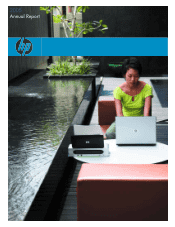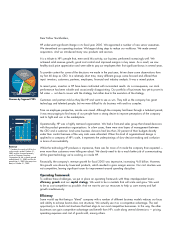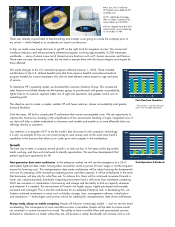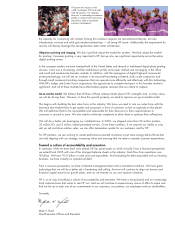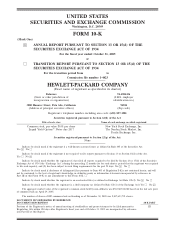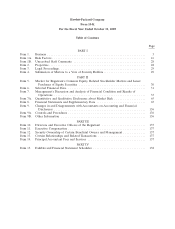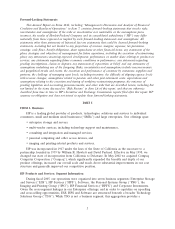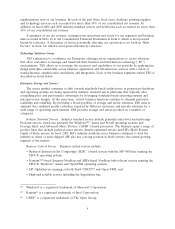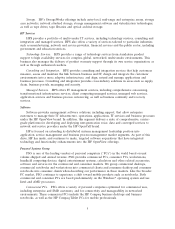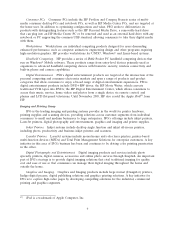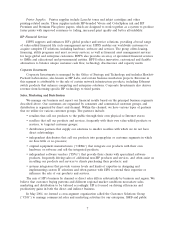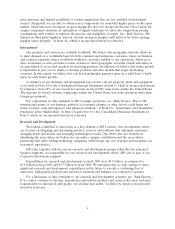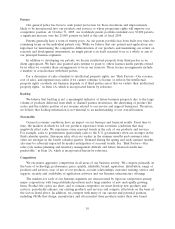HP 2005 Annual Report Download - page 4
Download and view the complete annual report
Please find page 4 of the 2005 HP annual report below. You can navigate through the pages in the report by either clicking on the pages listed below, or by using the keyword search tool below to find specific information within the annual report.
the capacity for consuming rich content. Driving this evolution requires not just advanced devices, but also
infrastructure, services and solid go-to-market partnerships — all strong HP assets. Additionally, the requirement for
security will heavily leverage the next-generation data center architecture.
Ubiquitous printing and imaging. We don’t just think about the market for printers. We think about the market
for printing. Consumer printing is very important to HP, but we also see significant opportunity across the entire
digital printing arena.
In the consumer market, we have invested both in the United States and abroad in web-based digital photo-printing
services. Color use is increasing, and the multifunction printer and copier markets are converging in the office
and small and medium-size business markets. In addition, with the emergence of digital high-end commercial
printing technology, we will see an increase in do-it-yourself marketing collateral, both inside companies and
through small commercial printing companies that can operate more efficiently and effectively with this technology.
With HP’s Indigo and Scitex Vision acquisitions, the opportunity to compete and grow in this broader market is
significant. And all of these markets have after-market supplies revenues that we intend to capture.
Go-to-market model. We believe that all three of these industry trends play to HP’s strengths and, in many cases,
we will be driving them. However, to drive this growth properly, we need to improve our go-to-market model.
This begins with building the best sales force in the industry. We know we need to arm our sales force with the
best tools that enable them to get quotes and proposals in front of customers as fast as anybody on the planet.
We will authorize them to be accountable and responsible for their decisions so their responsiveness to
customers is second to none. We also need to eliminate complexity to allow them to optimize their selling time.
We will do a better job leveraging our installed base. In 2005, we shipped more than 50 million printers,
30 million PCs and 2 million industry-standard servers. Given these numbers, if we improve our ability to cross
sell, up sell and drive solution sales, we can offer tremendous upside for our customers and for HP.
For HP partners, we are working to create performance-oriented incentives to put more energy behind those that
are truly aligning with our strategy, increasing value and ensuring that we meet or exceed customer expectations.
Toward a culture of accountability and execution
In summary, while we have hard work ahead, HP has great assets on which to build. From a financial perspective,
we exited fiscal 2005 with one of the strongest balance sheets in the industry. Cash flow from operations was
$8 billion. We have $13.9 billion in cash and cash equivalents. And excluding the debt associated with our leasing
business, we have virtually no operational debt.
From a resource perspective, we have a talented management team and a motivated workforce. We have great
technology that we will do a better job of marketing and selling. And we will continue to align our human and
financial capital around our growth plans, even as we execute on our cost structure initiatives.
HP is on its way to building a culture of accountability and execution. We have a strong brand and an increasingly
loyal customer base that wants to see HP win. And we will continue to expend every ounce of effort to make sure
that we live up to each one of our commitments to our customers, our partners, our employees and our stockholders.
Sincerely,
Mark V. Hurd
Chief Executive Officer and President
HP powers the majority of the
world’s exchange, ATM and credit-
card transactions. The company
also uses its technology to empower
people in underserved communities
around the world to accelerate
economic development.

